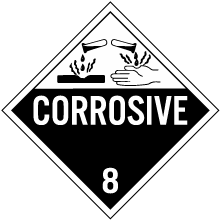See all of our Sodium Hydroxide Signs
What is Sodium Hydroxide / Caustic Soda?
Sodium hydroxide, also known as lye or caustic soda, is an alkali inorganic compound - a type of base that can neutralize acids and is soluble in water. Pure sodium hydroxide is a white crystalline odorless solid that absorbs moisture from the air. As a liquid, is colorless and denser than water. When dissolved in water or neutralized with acid it liberates substantial heat, which may be sufficient to ignite combustible materials.
Sodium hydroxide is commercially available in pellets, flakes, granules and as a 50% saturated solution. Sodium hydroxide is a highly versatile substance used to manufacture soaps, rayon, paper, explosives, dyestuffs, and petroleum products. It is also used in processing cotton fabric, laundering and bleaching, metal cleaning and processing, oxide coating, electroplating, and electrolytic extracting. It is commonly present in commercial drain and oven cleaners.
Due to its strong corrosive qualities, exposures to sodium hydroxide in its solid or solution form can cause skin and eye irritation. Sodium hydroxide can burn or eat away at any part of the body that it contacts. Breathing sodium hydroxide dust or mist causes mild or serious effects, depending on the amount of exposure. Effects may include sneezing, sore throat or runny nose. Severe inflammation of the lungs can occur.
Fire Protection Guide to Hazardous Materials - Edition 14th
| Chemical Name / CAS No. | Health | Flammability | Instability | Special Hazard | DOT Class | ID No. |
|---|---|---|---|---|---|---|
| Sodium Hydroxide 1310-73-2 |
3 | 0 | 1 | None | Class 8 Corrosive Material |
UN 1823 - Solid UN 1824 - Solution |
The Hazardous Chemical Data Compilation, previously known as NFPA 49, provides guidance on the hazards of chemicals to emergency personnel, safety professionals, inspection and enforcement officials on storage and fire fighting techniques that can be used in an emergency or in disaster planning.
Name: SODIUM HYDROXIDE
Synonyms: caustic soda, lye
Formula: NaOH
NFPA 30/OSHA Classification: n/a
DOT Class: Class 8, Corrosive material
Shipping Label: Corrosive
ID No: UN 1823 - solid; UN 1824 - solution
CAS No: 1310-73-2
Statement of Hazards: Corrosive. Either solid or concentrated solution.
Emergency Response Personal Protective Equipment: Wear special protective clothing and positive pressure self-contained breathing apparatus. Butyl rubber, natural rubber, Neoprene®, nitrile rubber, polyethylene, polyvinyl chloride, Teflon®, Viton®, or Saranex® barrier recommended.
Spill or Leak Procedures: Keep water away from release. Stop or control the leak, if this can be done without undue risk. Prompt cleanup and removal are necessary. Shovel into suitable dry container. Control runoff and isolate discharged material for proper disposal.
Fire Fighting Procedures: Extinguish fire using agent suitable for surrounding fire. Use water spray to keep fire-exposed containers cool.
Health Hazards: Corrosive. Causes severe eye and skin burns. Irritating to skin, eyes, and respiratory system.
Fire and Explosion Hazards: Not combustible.
Instability and Reactivity Hazards: Strong alkali. Dissolves in water releasing heat. Reacts with metals, such as aluminum, tin, and zinc, and may cause formation of hydrogen gas.
Storage Recommendations: Store in cool, dry, well-ventilated location. Separate from acids, water, and metals. Immediately remove and properly dispose of any spilled material.
Usual Shipping Containers: Bottles, cans, drums; tanks on trucks, rail cars, barges.
Physical Properties: White pellets, flakes, sticks, or solid cast. Deliquescent. May be shipped as water solution.
Melting Point: 604°F (318°C)
Boiling Point: 2534°F (1390°C)
Specific Gravity: 2.13
Solubility in Water: Soluble
Transport Information
Hazmat Placards are required for the transportation of sodium hydroxide. In the US, the Department of Transportation classifies sodium hydroxide as a hazard class 8. Corrosive material (Class 8) means a liquid or solid that causes irreversible damage to human skin at the site of contact within a specified period of time.
| Hazardous Material | Classification | UN Number | Hazard Class | Packing Class |
|---|---|---|---|---|
| Sodium hydroxide, solid | DOT US Department of Transportation |
UN1823 | 8 | II |
| Sodium hydroxide solution | DOT US Department of Transportation |
UN1824 | 8 | II |
§172.558 Corrosive placard.
(b) In addition to complying with §172.519, the background color on the CORROSIVE placard must be black in the lower portion with a white triangle in the upper portion. The base of the white triangle must be 38 mm ±5 mm (1.5 inches ±0.2 inches) above the placard horizontal center line. The text and class number must be white. The symbol and inner border must be black.

